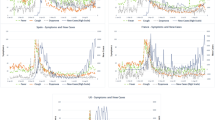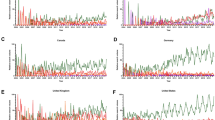Abstract
To assess whether Google search activity predicts lead-time for pediatric respiratory syncytial virus (RSV) encounters within a major health care system. Internet user search and health system encounter database analysis. Pediatric RSV encounter volumes across all clinics and hospitals in the Duke Health system were tabulated from 2005 to 2016. North Carolina Google user search activity for RSV were obtained over the same time period. Time series analysis was used to compare RSV encounters and search activity. Cross-correlation was used to determine the ‘lag’ time difference between Google user search interest for RSV and observed Pediatric RSV encounter volumes. Google search activity and Pediatric RSV encounter volumes demonstrated strong seasonality with predilection for winter months. Granger Causality testing revealed that North Carolina RSV Google search activity can predict pediatric RSV encounters at our health system (F = 5.72, p < 0.0001). Using cross-correlation, increases in Google search activity provided lead time of 0.21 weeks (1.47 days) prior to observed increases in Pediatric RSV encounter volumes at our health system. RSV is a common cause of upper airway obstruction in pediatric patients for which pediatric otolaryngologists are consulted. We demonstrate that Google search activity can predict RSV patient interactions with a major health system with a measurable lead-time. The ability to predict when illnesses in a population result in increased health care utilization would be an asset to health system providers, planners and administrators. Prediction of RSV would allow specific care pathways to be developed and resource needs to be anticipated before actual presentation.



Similar content being viewed by others
References
Griffiths, C., Drews, S. J., and Marchant, D. J., Respiratory syncytial virus: Infection, detection, and new options for prevention and treatment. Clin Microbiol Rev. 30(1):277–319, 2017. https://doi.org/10.1128/CMR.00010-16.
Byington, C. L., Wilkes, J., Korgenski, K., and Sheng, X., Respiratory syncytial virus-associated mortality in hospitalized infants and young children. Pediatrics. 135(1):e24–e31, 2015. https://doi.org/10.1542/peds.2014-2151.
Shi, T., McAllister, D. A., O'Brien, K. L. et al., Global, regional, and national disease burden estimates of acute lower respiratory infections due to respiratory syncytial virus in young children in 2015: A systematic review and modelling study. The Lancet. 390(10098):946–958, 2017. https://doi.org/10.1016/S0140-6736(17)30938-8.
Haynes, A. K., Prill, M. M., Iwane, M. K., and Gerber, S. I., Respiratory syncytial virus--United States, July 2012-June 2014. MMWR Morb Mortal Wkly Rep. 63(48):1133–1136, 2014.
Leader, S., and Kohlhase, K., Respiratory syncytial virus-coded pediatric hospitalizations, 1997 to 1999. Pediatr Infect Dis J. 21(7):629–632, 2002. https://doi.org/10.1097/01.inf.0000019891.59210.1c.
Ginsberg, J., Mohebbi, M. H., Patel, R. S., Brammer, L., Smolinski, M. S., and Brilliant, L., Detecting influenza epidemics using search engine query data. Nature. 457(7232):1012–1014, 2009. https://doi.org/10.1038/nature07634.
Centers for Disease Control and Prevention. Respiratory Syncytial Virus Infection (RSV) - Trends and Surveillance. https://www.cdc.gov/rsv/research/us-surveillance.html. Updated June 6, 2018. Accessed January 12, 2020.
Nuti, S. V., Wayda, B., Ranasinghe, I. et al., The use of google trends in health care research: A systematic review. PLoS ONE. 9(10):e109583, 2014. https://doi.org/10.1371/journal.pone.0109583.
Cho, S., Sohn, C. H., Jo, M. W. et al., Correlation between national influenza surveillance data and google trends in South Korea. PLoS ONE. 8(12):e81422, 2013. https://doi.org/10.1371/journal.pone.0081422.
Pollett, S., Boscardin, W. J., Azziz-Baumgartner, E. et al., Evaluating Google flu trends in Latin America: Important lessons for the next phase of digital disease detection. Clin Infect Dis. 64(1):34–41, 2017. https://doi.org/10.1093/cid/ciw657.
Olson, D. R., Konty, K. J., Paladini, M., Viboud, C., and Simonsen, L., Reassessing Google flu trends data for detection of seasonal and pandemic influenza: A comparative epidemiological study at three geographic scales. PLoS Comput Biol. 9(10):e1003256, 2013. https://doi.org/10.1371/journal.pcbi.1003256.
Malik, M. T., Gumel, A., Thompson, L. H., Strome, T., and Mahmud, S. M., "Google flu trends" and emergency department triage data predicted the 2009 pandemic H1N1 waves in Manitoba. Can J Public Health. 102(4):294–297, 2011.
Kang, M., Zhong, H., He, J., Rutherford, S., and Yang, F., Using Google trends for influenza surveillance in South China. PLoS ONE. 8(1):e55205, 2013. https://doi.org/10.1371/journal.pone.0055205.
Dugas, A. F., Hsieh, Y.-H., Levin, S. R. et al., Google flu trends: Correlation with emergency department influenza rates and crowding metrics. Clin Infect Dis. 54(4):463–469, 2012. https://doi.org/10.1093/cid/cir883.
Alicino, C., Bragazzi, N. L., Faccio, V. et al., Assessing Ebola-related web search behaviour: Insights and implications from an analytical study of Google trends-based query volumes. Infect Dis Poverty. 4:54, 2015. https://doi.org/10.1186/s40249-015-0090-9.
Bragazzi, N. L., Barberis, I., Rosselli, R. et al., How often people google for vaccination: Qualitative and quantitative insights from a systematic search of the web-based activities using Google trends. Hum Vaccin Immunother. 13(2):464–469, 2017. https://doi.org/10.1080/21645515.2017.1264742.
Welliver, R. C., Review of epidemiology and clinical risk factors for severe respiratory syncytial virus (RSV) infection. The Journal of Pediatrics. 143(5):112–117, 2003. https://doi.org/10.1067/S0022-3476(03)00508-0.
Kendrick, K., Stanek, D., and Blackmore, C., Morbidity and mortality weekly report. Cent. Dis. Control Prev. 63:1137, 2014.
Bourgeois, F. T., Valim, C., McAdam, A. J., and Mandl, K. D., Relative impact of influenza and respiratory syncytial virus in young children. Pediatrics. 124(6):e1072–e1080, 2009. https://doi.org/10.1542/peds.2008-3074.
Committee on Infectious Diseases, Updated guidance for palivizumab prophylaxis among infants and young children at increased risk of hospitalization for respiratory syncytial virus infection. Pediatrics 134(2):e620–e638, 2014.
Carneiro, H. A., and Mylonakis, E., Google trends: A web-based tool for real-time surveillance of disease outbreaks. Clin Infect Dis. 49(10):1557–1564, 2009. https://doi.org/10.1086/630200.
Acknowledgements
The authors would like to thank Google for providing open-access to their search term database.
Financial Disclosure
no authors have disclosures related to this manuscript.
Author information
Authors and Affiliations
Corresponding author
Ethics declarations
Conflict of Interest
No authors have conflicts related to this manuscript.
Additional information
Publisher’s Note
Springer Nature remains neutral with regard to jurisdictional claims in published maps and institutional affiliations.
This article is part of the Topical Collection on Systems-Level Quality Improvement
Rights and permissions
About this article
Cite this article
Crowson, M.G., Witsell, D. & Eskander, A. Using Google Trends to Predict Pediatric Respiratory Syncytial Virus Encounters at a Major Health Care System. J Med Syst 44, 57 (2020). https://doi.org/10.1007/s10916-020-1526-8
Received:
Accepted:
Published:
DOI: https://doi.org/10.1007/s10916-020-1526-8




